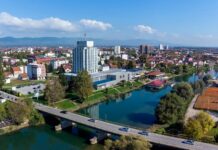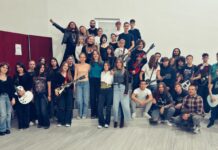One of the verses by the young singer Anđela Ignjatović, also known as Breskvica, in her newly released song “Gnezdo orlovo” (Eagle’s Nest), goes as follows: “Oblak sivi, sakri nebo” (Gray cloud, hide the sky). Although this title evokes the summer residence of Adolf Hitler himself, it actually refers to a popular-patriotic, ethno-composed song that was almost selected as the representative of Serbia at the upcoming Eurovision. It is important to note that I am personally not opposed to modernization, and the creation of new music inspired, in this case, by Slavic tradition. However, what are questionable are the performer herself (formerly known for serving exclusively commercial music) and the depiction of her presence in such an “anti-Eurovision” oriented community, such as the one in Serbia.
You see, I personally believe that it would be unfair to characterize Anđela in a negative context, but I simply find it logical to wonder: How did a girl who has often been a victim of attacks herself (due to piercings, tattoos, and her previous public appearances) suddenly become someone who symbolizes what the “average” citizen of Serbia supposedly wants to see, especially considering the assumption that the same “average” citizen does not even want to participate in that competition? It seems that often we ourselves do not know what we want, do we?
Culture in Serbia (and in the Balkans in general) has often experienced different waves. If we were to list the chronological order of these cultural waves, this text would simply turn into a novel; especially considering that culture itself (including “popular” culture) is fundamentally much older than the oldest borders in the atlas of the Balkan Peninsula. However, it is indisputable that, depending on geopolitical, social, and other circumstances, inventiveness and cultural priorities have changed. For example, we will see that local culture during the time of Ottoman occupation was significantly diminished and threatened, so it was important to preserve what was left. This was followed by various uprisings and revolutions, both political and cultural, which led to the emergence of new, often not very well-accepted directions at that time.
Unfortunately, wars and destruction have a negative impact on the development of culture (and everything else), and there have been too many of them in the Balkans, so it often happened that certain new cultural trends in the Balkans manifested even a century later (e.g., Romanticism in Serbian literature).
However, culture in these areas has survived and continues to survive, and despite often facing disapproval from the society itself, it continues to develop, as evidenced by numerous examples. For example, at the end of the last century, we had the phenomenon of the so-called “New Wave” in music in all major centers of the former country. This phenomenon managed to catapult the music of the former Yugoslavia into the officially recognized ranks of the world’s most respected music scenes, which was not a common occurrence in environments like ours. Undoubtedly, even then, that globally accepted performance encountered various local condemnations, accusations, and criticisms, but nevertheless, it endured, developed, and presented a picture of a different, socialist country.
However, the current situation in Serbia (and the region in general) is caught between the often forced desires to preserve tradition (which sounds paradoxical in a society that often does not even know it) and the other, opposing force, which views everything “domestic” as inherently bad and backward and, in its false liberalism, automatically exhibits its essential closed-mindedness towards everything that is not “modern”.
The truth, I would say, lies (as often) in the middle. Culture is fluid and has no beginning or end; even when repetitive; it takes on different forms in different interpretations. The concept of culture is variable, and we all “know” what it is, but in essence, we are not able to give a precise definition – and that’s how it should be. Culture (whether popular or Serbian) is precisely that, a universal concept that comes from within us and allows us to express or enjoy it in our own unique way. Personally, I believe that it would be entirely unfair to confine culture within certain limits, even if they are conventional, and I would stick to the principle: those who like it, let them watch/listen, and those who don’t, let them bypass it.
However, aware that we live in an environment where “what’s on the market” is most important, and where privacy is emphasized but rarely allowed, and that often we see everything through the lens of conspiracy theories, betrayal, and attacks on morality, I think we should all try to find those segments of culture that we enjoy and indulge in them. (Of course, we should try to separate the political situation from the cultural one.)
It seems that the “gray cloud” from the beginning of this text has indeed hidden the Serbian sky in many segments, including culture. But still, the seed of something different, which may not necessarily bring about fundamental change, and especially not kill some healthy spirit of tradition, exists, just as it did before. And it must exist because it represents the essential richness of a cultural environment, because just as a “different” young artist, Jovan Živadinović alias Džipsi, would say: The point is to show what Serbia can be, not what we are used to thinking Serbia is, understand?
Author: Darko Mandić













